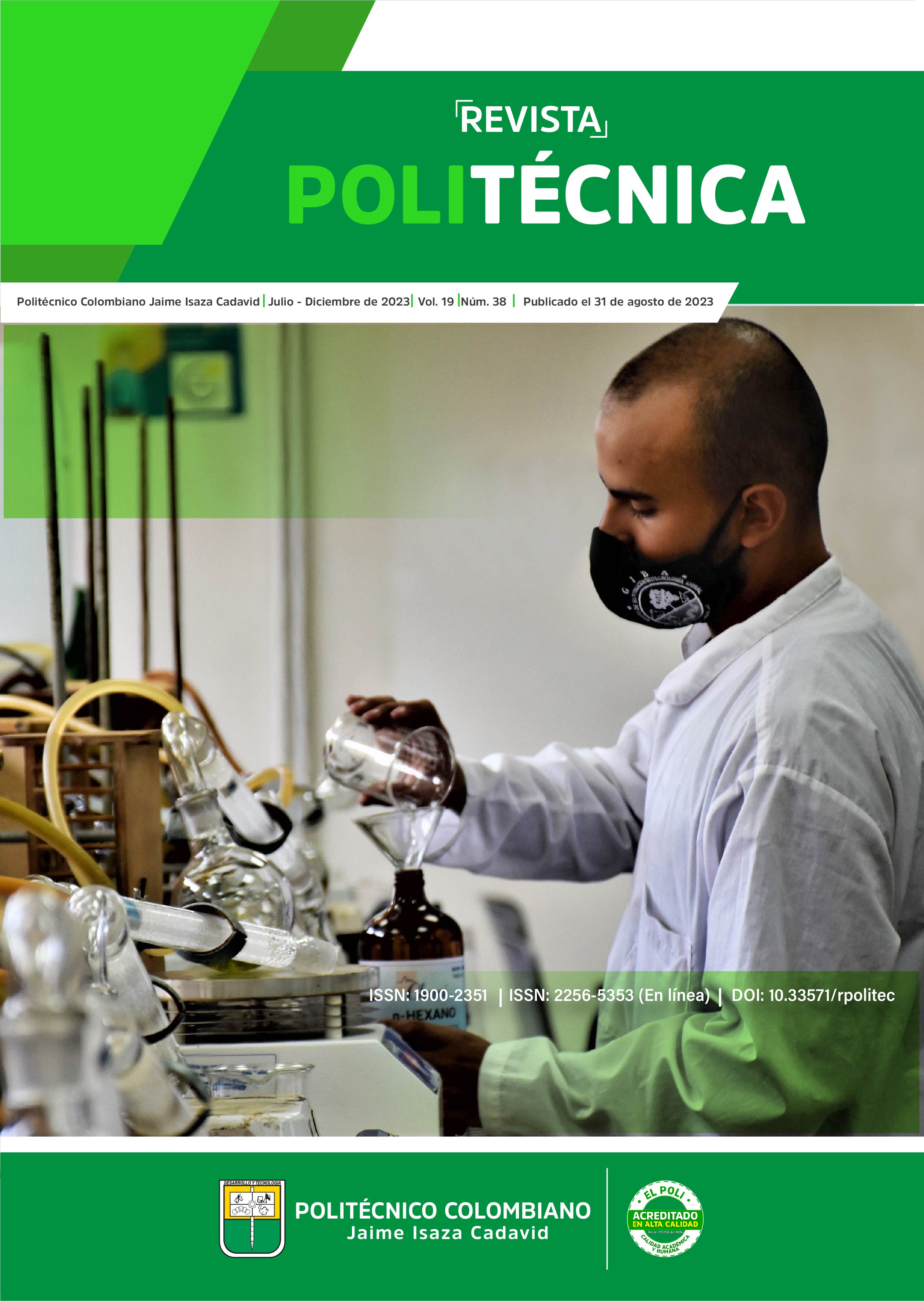Optimización de Isotermas de adsorción mediante Simulated Annealing
DOI:
https://doi.org/10.33571/rpolitec.v19n38a2Palabras clave:
adsorción, isoterma, carbón activadoResumen
El presente trabajo estudia el ajuste de los datos experimentales de las isotermas de adsorción en un sistema de cromo hexavalente como adsorbato y carbón activado como adsorbente. Los ensayos de adsorción consistieron en poner en contacto 0,1 gramo de adsorbente con soluciones de diferente concentración de cromo hexavalente durante 48 h a distintas temperaturas. Para el modelado se propuso un método distinto al tradicional, mediante el cual se optimiza la energía de activación de la adsorción de manera que se generen las contantes de equilibrio que minimicen el error cuadrático medio respecto a los datos experimentales. Para ello, se empleó Simulated Annealing como algoritmo de optimización. Una temperatura inicial de 1000, 10000 iteraciones y un tamaño de paso de 0,05 fueron los parámetros utilizados. Ambos métodos presentan ajustes adecuados, mostrando energías de activación del mismo orden. Esto indicaría que el algoritmo de optimización sería comparable a los procedimientos tradicionales.
The present work studies the adjustment of the experimental data of the adsorption isotherms in a system of hexavalent chromium as adsorbate and activated carbon as adsorbent. The adsorption tests consisted of using 0.1 gram of adsorbent with solutions of different concentrations of hexavalent chromium for 48 h at different temperatures. For the modeling, a method different from the traditional one was proposed, where the adsorption activation energy is optimized to generate the equilibrium constants that minimize the mean square error with respect to the experimental data. For this, Simulated Annealing was used as the optimization algorithm. An initial temperature of 1,000, 10,000 iterations, and a step size of 0.05 were the parameters used. Both methods present adequate adjustments, showing activation energies of the same order. This would indicate that the optimization algorithm would be comparable to traditional procedures.
Métricas de artículo
Resumen: 705 PDF: 282 HTML: 89Métricas PlumX
Citas
Nemerow, N. L., & Dasgupta, A. (1991). Industrial and hazardous waste treatment. United States.
Metcalf, L., Eddy, H. P., & Tchobanoglous, G. (1991). Wastewater engineering: treatment, disposal, and reuse (Vol. 4). New York: McGraw-Hill.
Owlad, M., Aroua, M. K., Daud, W. A. W., & Baroutian, S. (2009). Removal of hexavalent chromi-um-contaminated water and wastewater: a review. Water, air, and soil pollution, 200, 59-77.
https://doi.org/10.1007/s11270-008-9893-7
Chen, Q., Yao, Y., Li, X., Lu, J., Zhou, J. y Huang, Z. (2018). Comparison of heavy metal removals from aqueous solutions by chemical precipitation and characteristics of precipitates. Journal of Water Process Engineering, 26, 289-300.
https://doi.org/10.1016/j.jwpe.2018.11.003
Giri, A. K. y Cordeiro, M. N. D. (2021). Heavy metal ion separation from industrial wastewater using stacked graphene Membranes: A molecular dynamics simulation study. Journal of Molecular Liquids, 338, 116688.
https://doi.org/10.1016/j.molliq.2021.116688
Saeed, T., Alam, M. K., Miah, M. J. y Majed, N. (2021). Removal of heavy metals in subsurface flow constructed wetlands: Application of effluent recirculation. Environmental and Sustainability Indi-cators, 12, 100146.
https://doi.org/10.1016/j.indic.2021.100146
GracePavithra, K., Jaikumar, V., Kumar, P. S., & SundarRajan, P. (2019). A review on cleaner strat-egies for chromium industrial wastewater: present research and future perspective. Journal of Cleaner Production, 228, 580-593.
https://doi.org/10.1016/j.jclepro.2019.04.117
An, B. (2020). Cu (II) and As (V) adsorption kinetic characteristic of the multifunctional amino groups in chitosan. Processes, 8(9), 1194.
https://doi.org/10.3390/pr8091194
Allen, S. J., Gan, Q., Matthews, R. y Johnson, P. A. (2003). Comparison of optimised isotherm models for basic dye adsorption by kudzu. Bioresource Technology, 88(2), 143-152.
https://doi.org/10.1016/S0960-8524(02)00281-X
Barad, J. M., Kohli, H. P., & Chakraborty, M. (2022). Adsorption of hexavalent chromium from aqueous stream by maghemite nanoparticles synthesized by the microemulsion method. Energy Nex-us, 5, 100035.
https://doi.org/10.1016/j.nexus.2021.100035
Sulistiyo, C. D., Cheng, K. C., Su'andi, H. J., Yuliana, M., Hsieh, C. W., Ismadji, S., ... & Santoso, S. P. (2022). Removal of hexavalent chromium using durian in the form of rind, cellulose, and activat-ed carbon: Comparison on adsorption performance and economic evaluation. Journal of Cleaner Pro-duction, 380, 135010.
https://doi.org/10.1016/j.jclepro.2022.135010
Al-Othman, Z. A., Ali, R., & Naushad, M. (2012). Hexavalent chromium removal from aqueous me-dium by activated carbon prepared from peanut shell: adsorption kinetics, equilibrium and thermody-namic studies. Chemical engineering journal, 184, 238-247.
https://doi.org/10.1016/j.cej.2012.01.048
Sanchez-Hachair, A., & Hofmann, A. (2018). Hexavalent chromium quantification in solution: Com-paring direct UV–visible spectrometry with 1, 5-diphenylcarbazide colorimetry. Comptes Rendus Chi-mie, 21(9), 890-896.
https://doi.org/10.1016/j.crci.2018.05.002
El-Bindary, A. A., Hussien, M. A., Diab, M. A., & Eessa, A. M. (2014). Adsorption of Acid Yellow 99 by polyacrylonitrile/activated carbon composite: kinetics, thermodynamics and isotherm studies. Journal of molecular liquids, 197, 236-242.
https://doi.org/10.1016/j.molliq.2014.05.003
Langmuir, I. (1918). The adsorption of gases on plane surfaces of glass, mica and platinum. Jour-nal of the American Chemical society, 40(9), 1361-1403.
https://doi.org/10.1021/ja02242a004
Baccar, R., Blánquez, P., Bouzid, J., Feki, M., Attiya, H., & Sarrà, M. (2013). Modeling of adsorp-tion isotherms and kinetics of a tannery dye onto an activated carbon prepared from an agricultural by-product. Fuel Processing Technology, 106, 408–415.
https://doi.org/10.1016/j.fuproc.2012.09.006
Ghaedi, M., Ansari, A., & Sahraei, R. (2013). ZnS:Cu nanoparticles loaded on activated carbon as novel adsorbent for kinetic, thermodynamic and isotherm studies of Reactive Orange 12 and Direct yellow 12 adsorption. Spectrochimica Acta Part A: Molecular and Biomolecular Spectroscopy, 114, 687–694.
https://doi.org/10.1016/j.saa.2013.04.091
Ratan, J. K., Kaur, M., & Adiraju, B. (2018). Synthesis of activated carbon from agricultural waste using a simple method: Characterization, parametric and isotherms study. Materials Today: Proceed-ings, 5(2), 3334–3345.
https://doi.org/10.1016/j.matpr.2017.11.576
Ledesma, S., Avina, G., Sanchez, R. (2008). Practical considerations for simulated annealing im-plementation. Simulated Annealing, 20, 401e20.
Metropolis, N.A., Rosenbluth, A., Rosenbluth, M., Teller, A. y Teller, E. (1953). Equation of state calculations byfast computing machines. J. Chem. Phys, vol. 21, 1087–1092.
Publicado
Cómo citar
Número
Sección
Licencia
Derechos de autor 2023 Jorge Pellegrini, Jorge de Celis

Esta obra está bajo una licencia internacional Creative Commons Atribución-NoComercial-CompartirIgual 4.0.


























